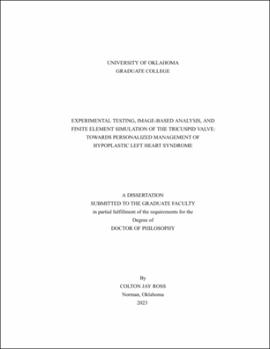| dc.description.abstract | In this dissertation, the tricuspid valve (TV) is researched from three perspectives - in vitro experimental testing, in vivo image analysis, and in silico modeling.
Starting with the in vitro studies, we build upon our previous biaxial mechanical characterization studies to provide a deeper understanding of the microstructure-mechanics relationships. In one study, we performed a three-step experimental procedure for quantifying the mechanical contributions of the collagen and elastin constituents to the bulk tissue function: (i) biaxial testing of the TV leaflets; (ii) treatment of the tissue with an enzyme to remove either the collagen or elastin constituent; and (iii) biaxial testing of the same enzyme-treated tissue to facilitate comparisons within the same specimen. For the collagen-removal testing, we found a greater compliance in the high-tension regime of the stress-strain behaviors in the enzyme-treated tissues, providing experimental evidence of collagen as the primary load-bearing component. Meanwhile, in the elastin-removal testing, we observed a significant increase in tissue stiffness post-treatment, suggesting that the elastin plays a crucial role in the transition between low and high tensions, such as by acting as a regulator of the collagen fiber kinematics. In the next in vitro study, we used a polarized light-based imaging modality in conjunction with biaxial testing to evaluate the affine fiber kinematics (AFK) assumptions for the TV leaflets. We found that the AFK theory generally underpredicted the fiber reorientations subject to the equibiaxial loading, with larger errors occuring when the tissue was subjected to the applied non-equibiaxial loading. Furthermore, larger AFK errors were observed with increasing collagen fiber reorientations, suggesting the AFK theory is better suited for relatively smaller fiber reorientations.
As a next step in the TV-focused research, we focused on quantifying the in vivo mechanics of the TV, with specific emphasis on a congenital condition called hypoplastic left heart syndrome (HLHS), in which underdevelopment of the left side of the heart causes significantly increased cardiac burden on the right side of the heart. Specifically, we developed a framework for analyzing echocardiograms to analyze the TV annulus mechanics and geometric properties, and performed comparisons of these metrics between newborns with and without HLHS. In this study, we found the HLHS-afflicted TV annulus is larger in circumference, area, and antero-posterior diameter, and becomes more circular and bent during valve closing than its healthy counterpart. From an engineering mechanics perspective, tissue strains did not differ significantly between the cohorts, which may provide an indication that the TV remodels in the HLHS condition to maintain tissue homeostasis throughout the cardiac cycle.
To further progress our understanding of the in vivo TV function, we performed in silico studies in the context of inverse finite element analysis. Specifically, we performed an exploratory study to assess how different factors affect the objective function search space. From this exploration, we found that: (i) an exponential-type material model yields a valley of nearly equivalent solutions; (ii) that the presence of noise in the comparison data (e.g., image-segmented point cloud data) can increase the width of this valley; and (iii) that a novel ``leaflet free-edge displacement" boundary condition provides a more desirable optimization search space than the typical in vivo-emulating scenario where the chordae tendineae are simulated. Along with this novel idea for simulating the TV closing, we also provided a demonstration of the use of Bayesian optimization for solving the inverse analysis problem in computationally tractable manner.
Overall, the research performed in this dissertation provides significant progress in three major areas of interest for understanding tricuspid valve function. Firstly, refined understandings of the microstructure-mechanics relationships and the collagen fiber kinematics will lead to the development of more accurate constitutive model forms. Secondly, the in vivo TV annulus image analysis framework can be used to perform long-term studies of valve function to understand tissue development in both healthy and diseased scenarios. Finally, the developed in silico analysis methods provide the next steps for fully realizing patient-specific treatments via simulation frameworks. | en_US |

